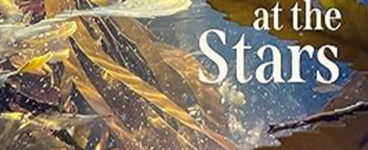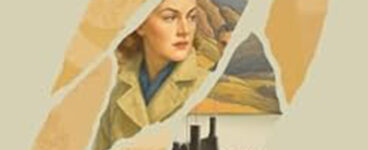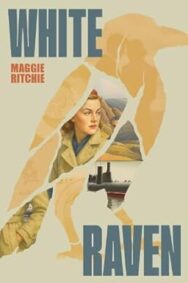‘The inspiration for this book was meeting 91-year-old Moira Beaty, one of the artists known as the Glasgow Girls.’
White Raven is an espionage thriller set in the Highlands at the early stages of the Cold War. BooksfromScotland caught up with author Maggie Ritchie to chat about its inspiration.
White Raven
By Maggie Ritchie
Published by Scotland Street Press
Hello Maggie, what can you tell our readers about your new novel, White Raven?
Bored with her life as a teacher in an Edinburgh girls’ school, artist Rosie is on a painting holiday in Crail in the East Neuk of Fife when she recognises Alex Kuznetsov from her previous life as a decoder at Bletchley Park.
Alex, a war hero and anti-Soviet intelligence officer, is in Crail to run a Russian language school for National Servicemen – the Cold War Joint Services School for Linguistics – to put Britain’s best and brightest young men through intensive training as translators and intelligence operators in the event of a third world war.
During an ardent courtship, Rosie is recruited as an art teacher at the JSSL. She soon finds out that there is more to her role as she is persuaded to take on a daring undercover espionage mission in a Highland country house – and finds that what starts out as a thrilling game has deadly consequences.
Inspired by the role Scottish women played in the Cold War during the 1950s, when the threat of nuclear war with the Soviet Union was at its height, White Raven is a story of courage, resilience – and betrayal.
White Raven moves from World War Two to the Cold War period. What is it that fascinates you about this period of time?
The inspiration for this book was meeting 91-year-old Moira Beaty, one of the artists known as the Glasgow Girls. During the course of the newspaper interview, she showed me a sketch of a handsome young man – her Russian lover when she was 18. Moira told me about her astonishing early life as a code breaker at Bletchley Park during World War Two and her love affair with a British intelligence officer with Russian roots who started the anti-Soviet intelligence unit at Bletchley.
I wanted to take the story on after the war. Bletchley Park, where class and gender were unimportant compared to your ability to break codes in a race against time against the Nazis – was a fascinating and liberating place for ordinary women like my heroine.
Moira told me that her years at the Park were the best of her life. I wondered what it would be like for women like her years later, in the 1950s, when they were expected to settle down and never mention their ultra secret work, which saved thousands of lives and helped bring the war to an early close.
My heroine, Rosie, who also worked at Bletchley Park during the war, relishes the thrills, intrigue and sense of once again playing a part on the world stage and having a cause to fight for when she enters the world of Cold War espionage.
White Raven is set in 1956, when Scotland had a crucial, strategic role in the Cold War in the northern seas between the Americans and the Russians – and why it was chosen as a base for nuclear powered and armed submarines.
I was intrigued when a TV director friend told me about an abandoned military base outside Crail in Fife, which in 1956 was the new home to the Cold War Joint Services School for Linguistics. The JSSL, also known as the School for Spies, put Britain’s best and brightest young men through intensive training as translators and intelligence operators in the event of a third world war.
Famous graduates include writer Michael Frayn, writer and actor Alan Bennett, dramatist Dennis Potter, the former Royal National Theatre director Sir Peter Hall, and the former governor of the Bank of England Eddie George. They were taught fluent Russian by eccentric White Russian émigrés and Soviet defectors. The convicted Soviet spy Geoffrey Prime was also one of the 6,000 alumni.
The school closed in 1960 with the ending of conscription, but you can still see the abandoned buildings on the former RNAS Crail (HMS Jackdaw) camp a few miles outside the village.
Could you tell us about how you approach your research in writing historical fiction?
As well as doing a huge amount of research in libraries, museums, art galleries, online and buying far too many books about the 1940s and 1950s, as well as memoirs and biographies of women spies and women who worked at Bletchley Park, I like to visit places where my books are set.
For White Raven, they include fascinating Bletchley Park, Crail, a picturesque fishing village in the East Neuk of Fife, Edinburgh, where I used to live, Pool Ewe in the Highlands, and the dramatic tiny Aberdeenshire fishing village of Crovie, where my lovely artist friend Emma has a cottage.
My most exotic research trip was to Shanghai, funded by a Society of Authors grant, for my previous book, Daisy Chain, which features some of the characters in White Raven, 20 years later.
Where possible, I also interview people who have had similar experiences to my characters, like the artist Moira Beaty for White Raven. For previous novels I’ve interviewed my late parents and a retired missionary priest about their time in Africa in the early 1970s for my novel Looking for Evelyn, based on my childhood in Zambia, and a sculptor who works in marble for Paris Kiss, for my debut novel about Rodin and Camille Claudel.
How do you balance the historical weight of your settings with the intimate story of your characters?
Settings and period detail – the latter conveyed with a light touch – are hugely important for transporting the reader into another time and place. I strive as far as possible to get the facts right but I’m writing novels, not biographies or history books, so the characters and their emotions, thoughts and motivations, as well as a compelling plot are just as, if not more, important.
I also think it’s important that we remember the amazing lives of people who came before us, their courage and the hardships and joys they experienced. It is said that travel broadens the mind, and I think that’s equally true of time travel.
You often write about women and their rebellion against societal constraints. Is there anything you want to say about the contemporary world with these historical explorations?
While women have come a long way, we are still held back by unequal pay and opportunities for advancement at work, sexism, sexual harassment, and too many women are subjected to violence and abuse, often in their own homes.
The advances we do enjoy are relatively recent – my mother, who was a young woman in the 1950s – was not allowed to go to university despite excelling at school, her name didn’t go on the house deeds, and she was expected to give up work as soon as she had children. It was why she encouraged my sister and I to go to university. Equally, she was appalled at how we had to juggle work and inadequate childcare and be pulled in different directions.
I like to explore how women over the ages have bravely resisted the constraints imposed on them, finding ways to express themselves and fulfil their ambitions while negotiating romantic love, marriage and the demands – and wonders – of motherhood.
I’m constantly fascinated by artists in general and women artists in particular who, as well as struggling creatively, fight to be taken seriously alongside their male peers, only to be too often forgotten, like Camille Claudel and the artists known as the Glasgow Girls.
If there was a film adaptation of White Raven – who do you see in the starring roles?
Saoirse Ronan who has the intelligent sensitivity and nobody’s-fool wryness to play Rosie Anderson, and Jack Lowden, who has the right scowl and world-weary impatience he perfected in Slow Horses to play the Russian love interest and spy Alex Kuznetsov. It helps that they are both Celts with all the contradictions that brings, and that they are married, so their relationship will not come across as too saccharine and be tempered by Scottish/Irish humour and some eye rolling.
As it’s coming up to the end of the year, could you tell us what your favourite books have been in 2025?
I’m reading Andrew Miller’s latest, The Land in Winter, which I’m very much enjoying as a gentle, thoughtful contrast to a gruesome but intriguing Spanish police thriller, La Novia Gitana (The Gypsy Bride) by Carmen Mola. I recently read The Mitford Girls, a biography by Mary S Lovell. I love Nancy Mitford’s books and it has made me want to re-read them for the umpteenth time.
White Raven by Maggie Ritchie is published by Scotland Street Press, priced £16.99.
ALSO IN THIS ISSUE

 Looking Down at the Stars by Christina Riley
Looking Down at the Stars by Christina Riley
‘To say, “I want you to see this” for no reason other than the belief that it will bring pleasure or …

 White Raven: A Q & A with Maggie Ritchie
White Raven: A Q & A with Maggie Ritchie
‘The inspiration for this book was meeting 91-year-old Moira Beaty, one of the artists known as the …













